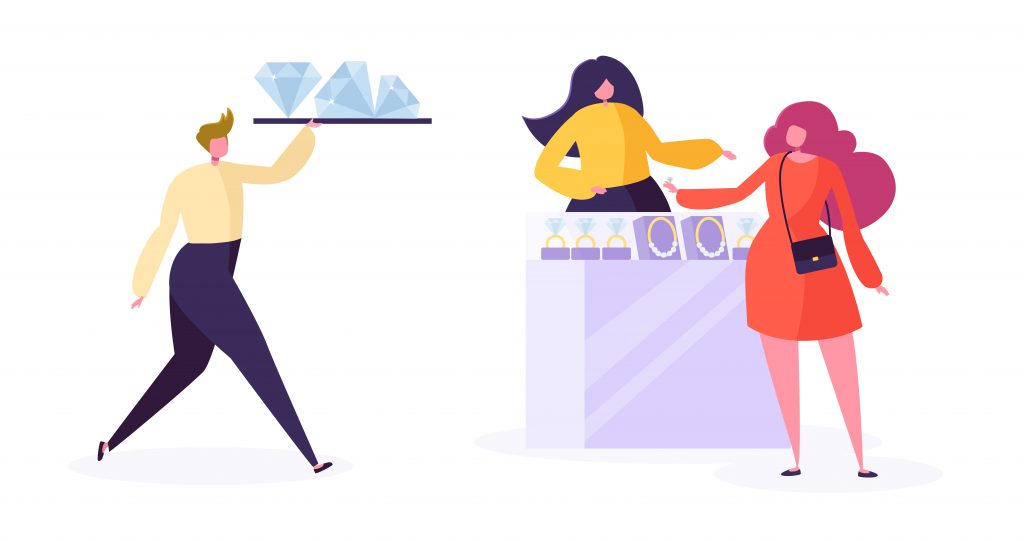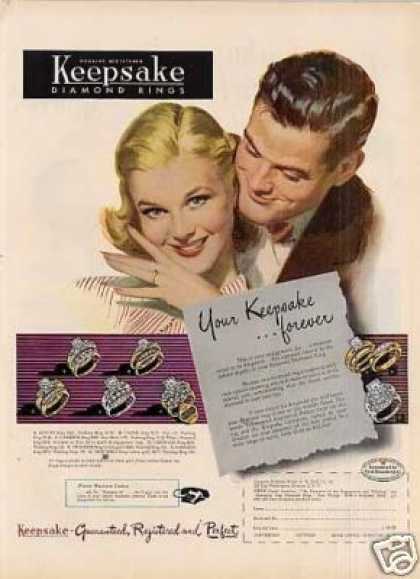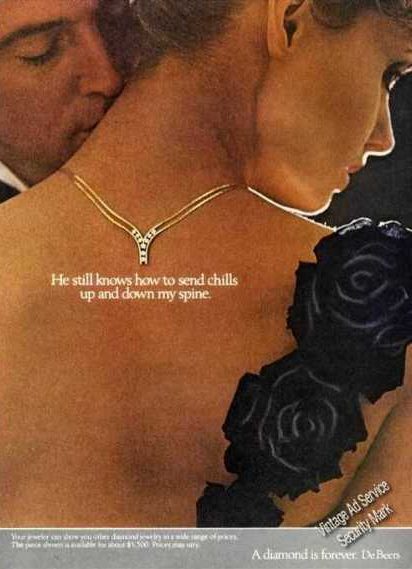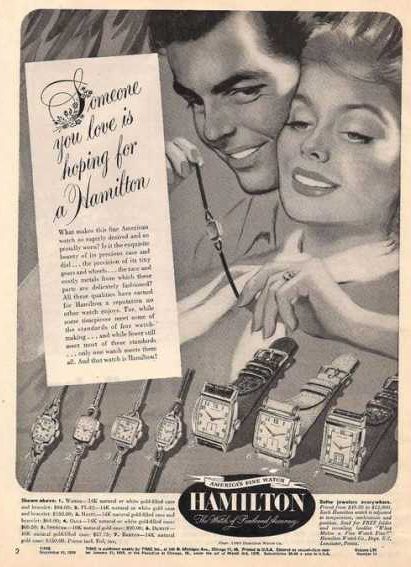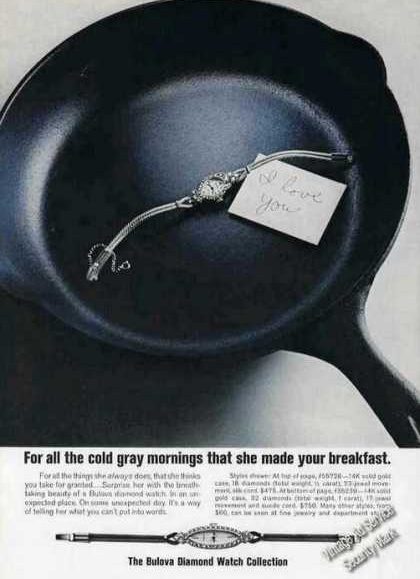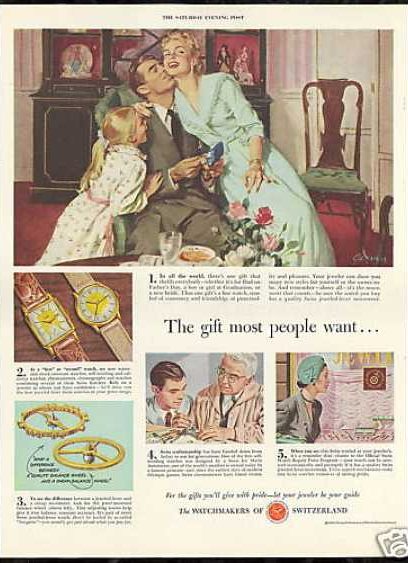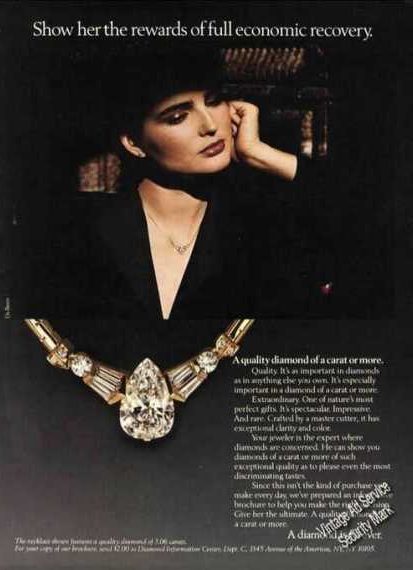THE IMPACT OF ACKNOWLEDGING THE FEMALE SOLE PURCHASER
JOYCE CHAMOUN

The jewelry industry is one with deep roots. It dates back to around 25,000 years ago with the first jewelry piece found in a cave in modern day Morocco. In relatively to its age, change comes slow in the industry. Its roots grow deep with tradition and a patriarchal structure which hold their ground to this day. However, women have proved to be a powerful force capable of not only growing but also uprooting the industry-imposed limits on their potential: gender disparity, sexism in the workplace, and male privilege.
For an industry that has stayed the same for so long, the rise and acknowledgement of the female self-purchaser has proven to be a monumental shift. The newfound focus on women buying jewelry for themselves has opened the door for industry wide innovation on how women are thought of and treated in the industry. It seems far-fetched to claim women were not taken seriously as buyers in an industry which produces products for them, but the dark reality behind all the glamour. Jewelry is actually the last luxury product targeted to men, according to Andrea Hill of Management Group.
It has only been a few years where a majority of brands decided to shift away from the idea a woman needs a man for a ring or really any big purchase. An idea which is a byproduct of meticulously crafted advertising campaigns that built an entire culture around the idea of “she said yes” or “her dream ring.” Now, advertising focuses on communicating the value of jewelry to women.
According to DeBeers Group Industry Report, women self-purchasers is a $43 billion market that grew by four percent in 2017. Now, more than 30 percent of diamond jewelry is being sold to women buying for themselves. The report also found only 13 percent of young women say they are influenced by their partner when purchasing jewelry, with 63 percent influenced by themselves.
The Women’s Jewelry Association (WJA), the premier empowerment organization for women in the jewelry and watch industries over the past three decades, hosts March is Me Month annually to build on the momentum of this shift. The initiative focuses on reminding women why their voice matters and how their purchase is powerful. They ask questions like what piece of jewelry did you buy? How did you invest in yourself? And How were you inspired to take your next step?”
“March is Me Month is more than a chance to self-purchase, it’s an opportunity to recognize that together our voices are more powerful than they are on their own,” Jennifer Markas, WJA Executive Director, said, “We each have a voice at the table with our spending power, but together we can change the face of the jewelry industry and every other industry. Women designing for women and women marketing to women makes sense.”
Stephanie Holland, founder of She-conomy, explains women control more than $20 trillion in worldwide spending and $7 trillion in the U.S. alone. Women will control two-thirds of consumer wealth in the U.S. over the next decade. Today, a total of 81 percent of jewelry is purchased in some fashion by women, either on their own or in cooperation with a partner. A major example of the industry inspired by this strongest growth engine, is the announcement of the “For Me, From Me” campaign by the Diamond Producers Association. Kate Peterson of Performance Concepts created the educational component of this campaign.
“The relevance to retailers is that more than 30 percent of diamond jewelry is being sold to women buying for themselves,” Peterson said to Instore Magazine, “A lot of stores are not capitalizing on that. Most people have been blissfully unaware of how much business they are missing, not in percentages, but in raw dollars. And we’re not losing it to other jewelry stores. We are giving it away to other industries.”
Back in the 80s, women in some parts of the business were not allowed to sell engagement rings to men. Fast forward to today and women are buying engagement rings for or without a man.
“It was not official policy, but it was kind of like Mad Men era stuff. It went from women were not allowed to sell diamond engagement rings to now women are buying their own engagement rings. You know, I bought my own. I was like I don’t trust my fiancé to know what I want. It is those cultural and behavioral and financial shifts you know. Especially with women being more financially independent, so all those evolutions are important when looking at the changes in the industry” Markas said.
For many of the women, they could not understand why so much of the business was focused solely on romance occasions from birthdays to anniversaries. The purchasing the power of a woman was all around ignored, especially in bridal. Sally Furrer, worked at Robbin’s Brothers, the World’s Biggest Engagement Ring Store, which was 95 percent bridal at the time.
“It really used to be like a woman would say, ‘oh you know if he picked it out, I know I am going to like it, because he picked it out.’ Right now, a young woman is like, ‘heck no, he is not going to pick it out, I know what I like,’” Furrer said, “In fact, at the store now, if a guy comes in by himself and didn’t have some pictures on Pinterest or he didn’t have a girlfriend who told him what she likes, we would discourage him from buying a ring. We say you know what let’s pick out the diamond and let her come back in and pick out a setting.”
The industry is realizing women do not need to be sold an outdated idea of romance, Markas explains. Sister designers, Ruby and Stella Saayed of RubyStella Jewelry are one of many companies with mottos around this idea of “buy your own damn ring.” Now, women buy jewelry for a variety of reasons from celebrating a promotion to simply treating themselves. It is out with the old idea that jewelry is a special occasion only commodity.
“If you want it, buy it. We can sweep ourselves of our own feet and we are here to help remind women that they can celebrate themselves. There should not be a difference between willing to pay thousands of dollars on shoes or paying so for jewelry”
Stella Saayed said
According to a Forbes.com report the most prominent group of female self-purchasers are Gen X females between the ages of 35 and 55. They tend to have been in the workforce for a significant number of years with an established career and income making them less hesitant to spend on themselves.
While the future seems as bright as the glitz and glamor of the jewelry itself, a multi-faceted dark side of the industry still exists. From the ongoing challenge of making sure diamonds are conflict-free and blood diamonds do not fall into retailers’ hands to the still relevant disparity between how men and women are treated. There have been great strides for women, but their role in the industry on the other end of sales is still covered by a ceiling constructed by a patriarchy. The problem with jewelry is the rate of change. When it does come, it comes slow. It is one of the slowest industries to follow the advancements in equality as it is still more common than ever for women to feel bullied and pitted against each other, according to the UK trade report.
GETTING “LITTLE LADIED”
Many women still face the issue of being disregarded, undermined, or talked down to. For many working in a big corporation means experiencing being “little ladied” for the first time. Furrer describes this as when “an older fellow might call you little lady and just out of hands dismiss whatever you were saying.”
Before starting her own firm, she worked in sales at Bucherer, the largest retail jewelry chain in Switzerland, and then at Robbins Brothers as Vice President of Merchandising. During her time in sales, she realized even though she was an expert at something and the person she was speaking to was not, being young and female meant she would be dismissed. She explains how many come to the realization their voice “is not going to be considered as expert as their male colleagues whether or not they have more expertise of information.”
More women than ever are founding jewelry brands and taking the lead as owner and designers yet acknowledging women’s positions of power is still an adjustment. At trade shows, with attendance by both industry traditionalists and newcomers, many women face the same treatment.
At the Tuscan, Arizona show Brenda Smith, founder and designer of Brenda Smith LLC, left her husband at her booth to run to the restroom. She returned to a man addressing her husband as the owner. He referred all his questions to her husband, totally ignoring her, and going so far as asking if she was his daughter.
She believes the problem in many of these instances is the reality the industry is such so tight knit that you do not want to burn any bridges with what could be interpreted as an offensive comeback.
For Furrer, the chance of burning bridges is better than silence: “I would have people call me honey, and I would just very evenly say to them my name’s not honey, I prefer to be called Sally. I knew then for a fact in their minds they’re probably like oh she’s going to be difficult, but I don’t think I really was difficult. I think I was always very fair, but I was also quite strong. I think you do have to stand up for yourself.”
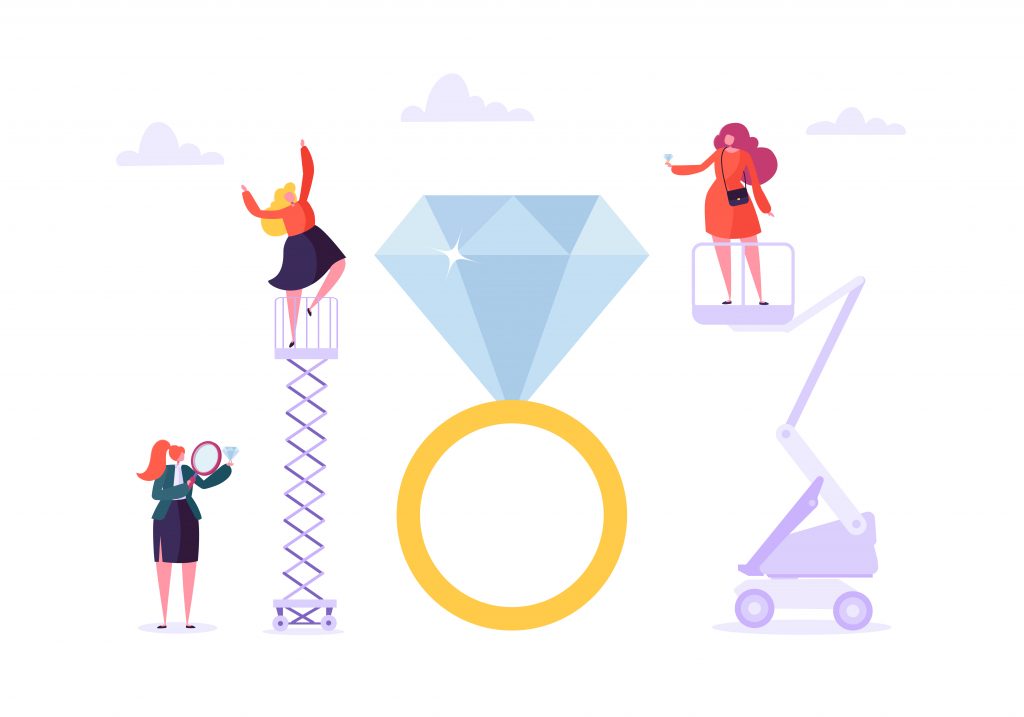
BOYS CLUB BOARDROOM
The most pressing issue is the imbalance in leadership in store ownership and management as men tend to hold these positions only reinforcing the existing system. Markas points out this is a problem seen across so many conservative industries.
She recalls an encounter she had at an industry gala for all the major manufacturers in jewelry called the 24 Karat Club. It was one of her first big events as Executive Director of the Women’s Jewelry Association. A pearl-dealer approached her and said “we don’t need you anymore. The Women’s Jewelry Association doesn’t need to exist.” Taken aback, she asked him why he felt this way to which he responded women are now managers and vice presidents. She gracefully reminded him how women still make 72 cents to the dollar compared to men, how women only make up 20 percent of all board leadership in America, and how the need to exist is relevant so long as educational, parental leave, and pay discrimination still exist. He quickly apologized.
Signet Jewelers has become infamous for these problems with an ongoing discrimination class action suit. Signet sold nearly $6 billion in jewelry a year as the largest jewelry retailer in the United States. In 2017, they were sued by 69,000 female employees and former employees for sexual harassment and discrimination in an ongoing class arbitration proceeding. Accusations include men in supervisory roles sexually harassing younger saleswomen, making degrading comments, and demanding sexual favors in exchange for a promotion. Cortney Conde, Executive Director of True View AR, is a member of the class after working for Jared and noticing the gender gap and the disparity within the organization firsthand.
“It has been a couple years now and we may not see anything for another three years who knows, but I saw it take a real toll on myself and my female colleagues. Long story short with it, I am really glad to not be a part of that brand anymore because that is definitely a culture, I am not interested in participating in. It was a weird experience to say the least,” Conde said.
She elaborates on her personal experience with a lot of what Signet is accused of. At the corporate wide regional sales meeting, she would notice 97 percent of the store managers, regional managers, district managers, and vice presidents were men, while 99 percent of the salespeople were women. Across the board leadership was male, while the sales staff was female. This was only affirmed when she was passed over for two promotions in favor of two male colleagues, something she said also happened to several others of her female coworkers. Aside from leadership representation women face the same pay disparities they do in other industries.
“What I find fascinating is, you know, I have women who come to me who are 50 years old who have been dealing diamonds and gems for 25 years breaking down crying in my office saying “oh my god, you don’t understand, women are treated so poorly,” Markas said, “ You know, I go in to sell my diamonds and I’m getting 30 percent less than if a male goes in there and sells his diamonds. So, there is still a lot of inequity.”
NOT ALL BAD
It would be ingenuine to vilify all men in the industry. Beyond being not true, this undermines the reality a lot of women, despite being victim to at least one of the disparities discussed, have found great mentorship from men in the industry.
Smith remembers being seven months pregnant and still wanting to work. She laughs at how she actually asked if her then boss was “really was hiring her,” because she could never imagine another woman hiring a woman so late in her pregnancy.
“I have experienced men who are super supportive and encouraging and not intimated by women. With women on the other hand, especially women who are older, there is always something holding them back. They don’t want to push you ahead, even though I feel like they should, and we would have gotten way more ahead by now,” Smith said.
Perhaps this is because there is an indoctrinated cattiness between women, Saayed suggests. She feels as though we have been taught from personal lives where we all are competing for the best suitor to business where we think there is just one spot.
“I think that it will change but it needs the older generations to really show the younger women how to do things and to stop hoarding onto industry secrets. Especially in jewelry, which is a very secretive industry, we need to normalize divulging secrets,” Saayed said.
Furrer is one of many who found great mentorship from her bosses at the time, Skip and Steve Robbins. She ended up staying with the company for 27 years because of the culture they fostered. She remembers so much she is thankful for through them like the fact even though they both had sons they decided they would not join the business or never making her feel like there was an opportunity off limits.
“It is amazing how dismissive men can be when they underestimate you, you know. Skip and Steve would always be there for me and gave me every opportunity I could ask for,” Furrer said. “They gave me every opportunity I could ask for. There was so much that attracted me, like the fact even though they both had two sons they decided neither of their children would come into the business, so I never felt like there would be a transition where I get moved aside.”
That being said and all the praise aside, Furrer still faced the hard reality someone reporting to her was making more money than she was. She believes women need to be taught to research and know their value and demand their worth when it is deserved.
“I probably had the most difficult conservations I would have with Steven about money and I would push, and push and we would have negotiations that would last months sometimes until I finally felt like it was there. It was never about the money. It was really about respect and how when you value someone you pay them appropriately. They were always one hundred percent supportive, but where they did let me down was on the money I have to admit. Eventually I was at a very good place, but you know it took a lot. It was a fight for me to get there.”
Sally Furrer
Ultimately, the future seems to rely on collaborative efforts from men and woman.
Markas believes this strongly with the WJA welcoming both women and men into its membership.
“We embrace our male members because connecting with them means we are building stronger bonds and business relationships. Working toward equality in the workplace in our industry is no small feat. It cannot be done without the mentorship and advocacy of our male colleagues. We need to continue harnessing their support so that we can level the field when it comes to more women in the boardroom, more money in our paychecks, and greater access to capital to grow our businesses, Markas said “the truth of the matter is we live in a very patriarchal society. So, without gaining the buy-in of our male colleagues and superiors it is going to be really hard to fight for what we deserve.”
